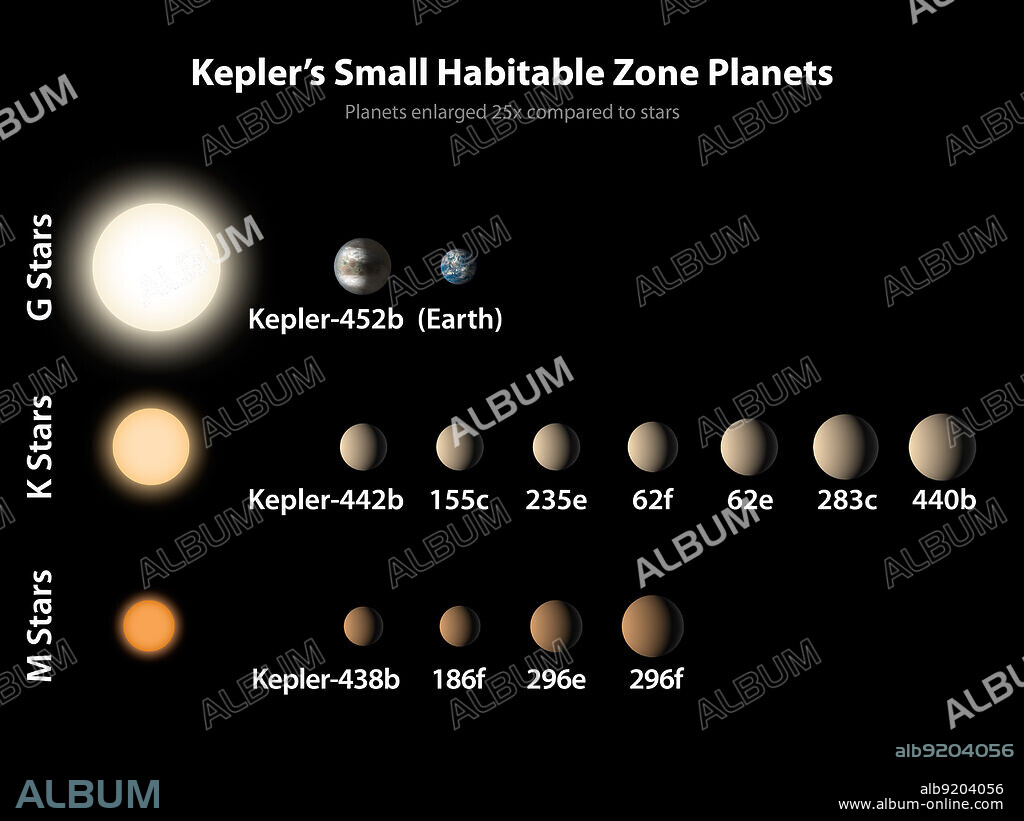alb9204056
Exoplanets, Small Habitable Zone Planets

|
Add to another lightbox |
|
Add to another lightbox |



Title:
Exoplanets, Small Habitable Zone Planets
Caption:
Of the 1,030 confirmed planets from Kepler, a dozen are less than twice the size of Earth and reside in the habitable zone of their host stars. In this diagram, the sizes of the exoplanets are represented by the size of each sphere. These are arranged by size from left to right, and by the type of star they orbit, from the M stars that are significantly cooler and smaller than the sun, to the K stars that are somewhat cooler and smaller than the sun, to the G stars that include the sun. The sizes of the planets are enlarged by 25 times compared to the stars. The Earth is shown for reference. NASA Ames manages Kepler's ground system development, mission operations and science data analysis. NASA's Jet Propulsion Laboratory managed Kepler mission development. Ball Aerospace & Technologies Corp. in Boulder, Colo., developed the Kepler flight system and supports mission operations with JPL at the Laboratory for Atmospheric and Space Physics at the University of Colorado in Boulder. The Space Telescope Science Institute in Baltimore archives, hosts and distributes the Kepler science data. Kepler is NASA's 10th Discovery Mission and is funded by NASA's Science Mission Directorate at the agency's headquarters in Washington. Release date July 23, 2015.
Credit:
Album / NASA/Ames/JPL-Caltech / Science Source
Releases:
Model: No - Property: No
Rights questions?
Rights questions?
Image size:
Not available
Print size:
Not available
Keywords:
2010S • 2015 • 21ST CENTURY • 21TH CENTURY • ART • ASTRONOMY • ASTRONOMY: OBSERVATORY • BODY • CELESTIAL • CENTURY • COMPARE • DEEP • EARTH • EARTH-LIKE • EXOPLANET • EXOPLANETS • GRAPHIC • HABITABILITY • HABITABLE • HEAVENLY • ILLUSTRATION • INHABITABLE • JC6188 • KEPLER • KEPLER-155C • KEPLER-186F • KEPLER-235E • KEPLER-283C • KEPLER-296E • KEPLER-296F • KEPLER-438B • KEPLER-440B • KEPLER-442B • KEPLER-45B • KEPLER-62E • KEPLER-62F • MAIN-SEQUENCE • MISSION • OBSERVATORY • ORRERY • OUTER • OUTERSPACE • PLANET • PLANETARIUM • PLANETARY • PLANETS • SMALL • SPACE (COSMOS) • SPACE • SPATIAL • STAR • SYSTEM • TERRAN • TERRESTRIAL • TINY • ZONE
 Pinterest
Pinterest Twitter
Twitter Facebook
Facebook Copy link
Copy link Email
Email

